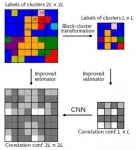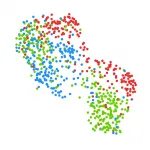Less is more? New take on machine learning helps us "scale up" phase transitions
Features of large systems yielded from tiny simulations with super-resolution techniques
2021-05-29
(Press-News.org) Tokyo, Japan - Researchers from Tokyo Metropolitan University have enhanced "super-resolution" machine learning techniques to study phase transitions. They identified key features of how large arrays of interacting "particles" behave at different temperatures by simulating tiny arrays before using a convolutional neural network to generate a good estimate of what a larger array would look like using "correlation" configurations. The massive saving in computational cost may realize unique ways of understanding how materials behave.
We are surrounded by different states or "phases" of matter i.e. gases, liquids, and solids. The study of phase transitions, how one phase transforms into another, lies at the heart of our understanding of matter in the universe, and remains a hot topic for physicists. In particular, the idea of universality, where wildly different materials behave in similar ways thanks to a few shared features, is a powerful one. That's why physicists study model systems, often simple grids of "particles" on an array that interact via simple rules. These models distill the essence of the common physics shared by materials and, amazingly, still exhibit many of the properties of real materials, like phase transitions. Due to their elegant simplicity, these rules can be encoded into simulations that tell us what materials look like under different conditions.
However, like all simulations, the trouble starts when we want to look at lots of particles at the same time. The computation time required becomes particularly prohibitive near phase transitions, where dynamics slows down, and the "correlation length," a measure of how the state of one atom relates to the state of another some distance away, grows larger and larger. This is a real dilemma if we want to apply these findings to the real world: real materials generally always contain many more orders of magnitude of atoms and molecules than simulated matter.
That's why a team led by Professors Yutaka Okabe and Hiroyuki Mori of Tokyo Metropolitan University, in collaboration with researchers in Shibaura Institute of Technology and Bioinformatics Institute of Singapore, have been studying how to reliably extrapolate smaller simulations to larger ones using a concept known as an inverse renormalization group (RG). The renormalization group is a fundamental concept in the understanding of phase transitions and led Wilson to be awarded the 1982 Nobel Prize in Physics. Recently, the field met a powerful ally in convolutional neural networks (CNN), the same machine learning tool helping computer vision identify objects and decipher handwriting. The idea would be to give an algorithm the state of a small array of particles and get it to "estimate" what a larger array would look like. There is a strong analogy to the idea of super-resolution images, where blocky, pixelated images are used to generate smoother images at a higher resolution.
The team has been looking at how this is applied to "spin" models of matter, where particles interact with other nearby particles via the direction of their "spins." Previous attempts have particularly struggled to apply this to systems at temperatures above a phase transition, where configurations tend to look more random. Now, instead of using spin configurations i.e. simple snapshots of which direction the particle spins are pointing, they considered correlation configurations, where each particle is characterized by how similar its own spin is to that of other particles, specifically those which are very far away. It turns out correlation configurations contain more subtle queues about how particles are arranged, particularly at higher temperatures.
Like all machine learning techniques, the key is to be able to generate a reliable "training set". The team developed a new algorithm called the block-cluster transformation for correlation configurations to reduce these down to smaller patterns. Applying an improved estimator technique to both the original and reduced patterns, they had pairs of configurations of different size based on the same information. All that's left is to train the CNN to convert the small patterns to larger ones.
The group considered two systems, the 2D Ising model and the three-state Potts model, both key benchmarks for studies of condensed matter. For both, they found that their CNN could use a simulation of a very small array of points to reproduce how a measure of the correlation g(T) changed across a phase transition point in much larger systems. Comparing with direct simulations of larger systems, the same trends were reproduced for both systems, combined with a simple temperature rescaling based on data at an arbitrary system size.
A successful implementation of inverse RG transformations promises to give scientists a glimpse of previously inaccessible system sizes, and help physicists understand the larger scale features of materials. The team now hopes to apply their method to other models which can map more complex features such as a continuous range of spins, as well as the study of quantum systems.
INFORMATION:
This work was supported by a Grant-in-Aid for Scientific Research from the Japan Society for the Promotion of Science, a Research Fellowship for Young Scientists from the Japan Society for the Promotion of Science, and the A*STAR (Agency for Science, Technology and Research) Research Attachment Programme of Singapore.
[Attachments] See images for this press release:

ELSE PRESS RELEASES FROM THIS DATE:
2021-05-29
Highlight
Among individuals with healthy kidneys, those with more frequent depressive symptoms were more likely to show signs of rapid kidney function decline over a median follow-up of 4 years.
Washington, DC (May 28, 2021) -- In a study of adults with normal kidney function, those who had frequent depressive symptoms were more likely to later experience a rapid decline in kidney function. The study will appear in an upcoming issue of CJASN.
Depression is a common condition in middle-aged and older adults, and it can contribute to a variety of mental and physical problems. Previous research has found a link between depressive symptoms and rapid kidney function decline in patients with chronic kidney disease (CKD). To look ...
2021-05-28
In 2015, nearly half of Hawai?i's coral reefs were affected by the most severe bleaching event to date. Coral bleaching occurs when warmer-than-normal ocean temperatures prompt corals to expel the algae that normally live inside them and on which the corals rely for food.
Bleaching events are dismaying, but corals can sometimes recover, while others resist bleaching altogether. In a new study in the journal Proceedings of the National Academy of Sciences, researchers led by Katie Barott of the University of Pennsylvania found that these battle-tested, resilient corals could thrive, even when transplanted to a different environment and subjected to additional heat stress. The findings offer hope that hardy corals could ...
2021-05-28
Boulder, Colo., USA: The Geological Society of America regularly publishes
articles online ahead of print. For April, GSA Bulletin topics
include multiple articles about the dynamics of China and Tibet; new
insights into the Chicxulub impact structure; and the dynamic topography of
the Cordilleran foreland basin. You can find these articles at
https://bulletin.geoscienceworld.org/content/early/recent
.
Tectonic and eustatic control of Mesaverde Group
(Campanian-Maastrichtian) architecture, Wyoming-Utah-Colorado region,
USA
Keith P. Minor; Ronald J. Steel; Cornel Olariu
Abstract:
We describe and analyze the depositional history and stratigraphic
architecture of the Campanian and Maastrichtian ...
2021-05-28
WACO, Texas (May 28, 2021) - About 36 million people have blindness including 1 million children. Additionally, 216 million people experience moderate to severe visual impairment. However, STEM (science, technology, engineering and math) education maintains a reliance on three-dimensional imagery for education. Most of this imagery is inaccessible to students with blindness. A breakthrough study by Bryan Shaw, Ph.D., professor of chemistry and biochemistry at Baylor University, aims to make science more accessible to people who are blind or visually impaired through small, candy-like models.
The ...
2021-05-28
Five researchers shed new light on a key argument to reduce greenhouse gases (GHG): they provided the first economic analysis of conversion factors of other GHG like methane into their CO2 equivalent in overshoot scenarios. Although the United Nations Framework Convention on Climate Change (UNFCCC) considers settling for one value of reference (known as "Common Metric") to make this conversion among the Paris Agreement, the models presented here show the economic advantage of flexibility between various factors of conversion. "A key notion in the UNFCCC is to reduce GHG emissions in the least costly way so as to ensure global benefits" highlights Katsumasa Tanaka, primary author of the Science Advances study.
The research provides series of dynamic variations of ...
2021-05-28
A study coordinated by Luís Graça, principal investigator at the Instituto de Medicina Molecular João Lobo Antunes (iMM; Portugal) and Professor at the Faculty of Medicine of the University of Lisbon (FMUL) used lymph nodes, tonsils and blood, to show how the cells that control production of antibodies are formed and act. The results published now in the scientific journal Science Immunology* unveiled key aspects about the regulation of antibody production, with significant importance for diseases where antibody production is dysregulated such as autoimmune diseases or allergies.
In the last few ...
2021-05-28
A new study of dozens of wild fish species commonly consumed in the Peruvian Amazon says that people there could suffer major nutritional shortages if ongoing losses in fish biodiversity continue. Furthermore, the increasing use of aquaculture and other substitutes may not compensate. The research has implications far beyond the Amazon, since the diversity and abundance of wild-harvested foods is declining in rivers and lakes globally, as well as on land. Some 2 billion people globally depend on non-cultivated foods; inland fisheries alone employ some 60 million people, and provide the primary source of protein for some 200 million. The study appears this week in the journal Science Advances.
The ...
2021-05-28
Centuries-old smoke particles preserved in the ice reveal a fiery past in the Southern Hemisphere and shed new light on the future impacts of global climate change, according to new research published in Science Advances.
"Up till now, the magnitude of past fire activity, and thus the amount of smoke in the preindustrial atmosphere, has not been well characterized," said Pengfei Liu, a former graduate student and postdoctoral fellow at the Harvard John A. Paulson School of Engineering and Applied Sciences (SEAS) and first author of the paper. "These results have importance for understanding the evolution of climate change from the 1750s until ...
2021-05-28
Since the onset of the CRISPR genetic editing revolution, scientists have been working to leverage the technology in the development of gene drives that target pathogen-spreading mosquitoes such as Anopheles and Aedes species, which spread malaria, dengue and other life-threatening diseases.
Much less genetic engineering has been devoted to Culex genus mosquitoes, which spread devastating afflictions stemming from West Nile virus--the leading cause of mosquito-borne disease in the continental United States--as well as other viruses such as the Japanese encephalitis virus (JEV) and the pathogen causing avian malaria, a threat to ...
2021-05-28
DALLAS - May 28, 2021 - A study of gene activity in the brain's hippocampus, led by UT Southwestern researchers, has identified marked differences between the region's anterior and posterior portions. The END ...
LAST 30 PRESS RELEASES:
[Press-News.org] Less is more? New take on machine learning helps us "scale up" phase transitions
Features of large systems yielded from tiny simulations with super-resolution techniques






